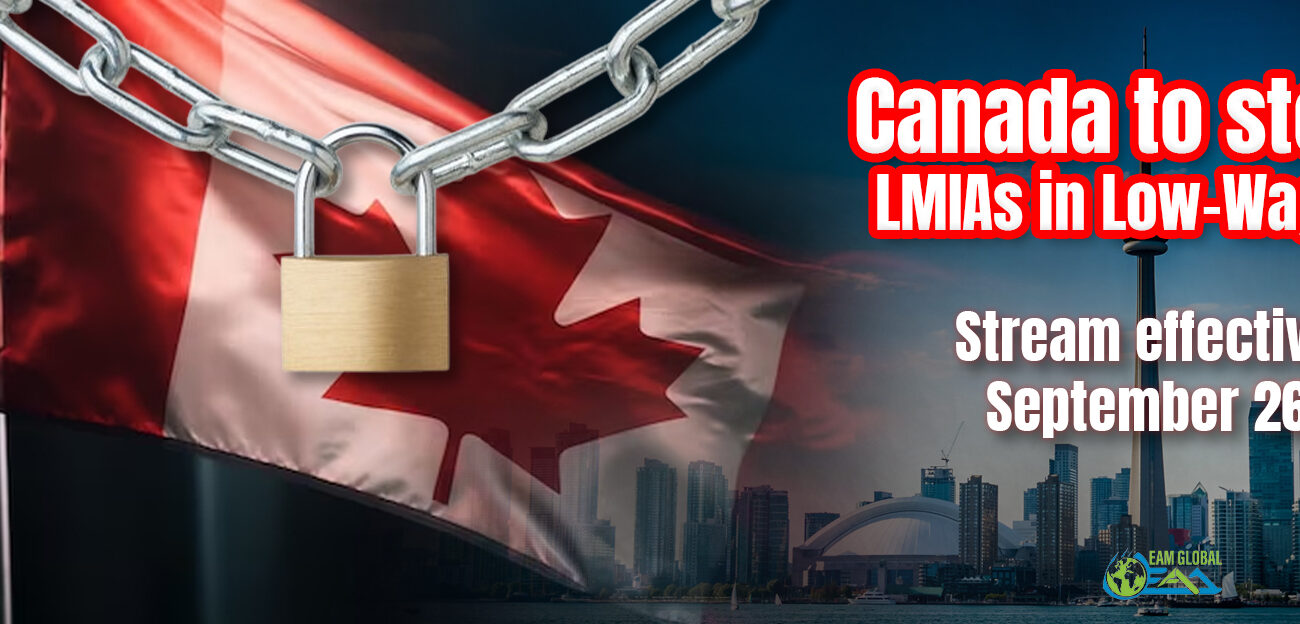
Canada to Stop LMIAs in Low-Wage Stream Effective September 26, 2024
Introduction
The Canadian Government has announced significant changes to its Temporary Foreign Worker (TFW) Program, specifically targeting the processing of Labour Market Impact Assessments (LMIAs) in the Low-Wage stream. Starting September 26, 2024, the government will stop processing LMIAs in metropolitan cities with an unemployment rate of 6% or higher. This decision is part of a broader strategy to reduce reliance on foreign workers and to prioritise Canadian talent, especially in regions experiencing higher unemployment rates.
These changes reflect the government’s commitment to ensuring that Canadian workers are given priority in the job market. As the country’s labour market dynamics shift, marked by a rising unemployment rate, this move aims to address the misuse of the TFW Program and to encourage employers to invest in the domestic workforce.
Background on the Temporary Foreign Worker (TFW) Program
The TFW Program was established to help Canadian employers fill labour shortages when qualified Canadian workers were not available. Historically, this program has played a crucial role in supporting various industries by allowing businesses to hire foreign workers temporarily. However, as Canada’s labour market evolved, the program became subject to scrutiny, especially concerning its impact on domestic employment opportunities.
Key Changes Effective September 26, 2024
The government’s decision to halt the processing of LMIAs in the Low-Wage stream for certain areas is just one of the many changes being implemented. Let’s delve into the specific changes and their implications:
Labour Market Impact Assessment (LMIA) Refusals in High Unemployment Areas
An LMIA is a document that Canadian employers need to obtain before hiring a foreign worker. It proves that there is a need for a foreign worker to fill the job and that no Canadian worker is available to do it. Starting September 26, 2024, the government will refuse to process LMIAs in the Low-Wage stream for census metropolitan areas where the unemployment rate is 6% or higher. This change is significant as it directly impacts employers in regions with high unemployment, forcing them to look more closely at the local talent pool.
Exceptions for Critical Sectors
Despite the new restrictions, the government has identified several critical sectors that will be exempt from the LMIA refusals:
- Primary Agriculture: Jobs related to farming and agricultural production.
- Food Processing: Roles in the processing and manufacturing of food products.
- Fish Processing: Positions in the processing of seafood and fish products.
- Construction: Jobs in building, infrastructure, and related fields.
- Healthcare: Roles within hospitals, clinics, and other healthcare facilities.
These exceptions highlight the government’s understanding of the vital role these sectors play in maintaining food security and public health, as well as in supporting essential infrastructure.
10% Cap on Foreign Workers
In addition to the LMIA refusals, the government is also implementing a stricter cap on the number of foreign workers an employer can hire through the TFW Program. As of September 26, 2024, employers will be limited to hiring no more than 10% of their total workforce through the TFW Program, a reduction from the previous 20% cap that was put in place earlier in March 2024. This change is intended to further prioritise Canadian workers by limiting the number of foreign workers in the labour market.
Reduced Employment Duration
Another major change involves the reduction of the maximum duration of employment for workers hired through the Low-Wage stream. Previously, foreign workers could be employed for up to two years. However, starting September 26, 2024, this duration will be reduced to one year. This change will likely have a significant impact on both employers and foreign workers, as it reduces the stability and continuity of employment for temporary foreign workers.
Government’s Focus on Canadian Workers
The Canadian Government, under the leadership of Minister of Employment, Workforce Development, and Official Languages Randy Boissonnault, has made it clear that these changes are designed to put Canadian workers first. The TFW Program was originally intended to address labour shortages when qualified Canadians were not available. However, as the job market evolves, the government is shifting its focus toward investing in the domestic workforce.
Minister Boissonnault emphasised that the changes will help ensure that the TFW Program meets the needs of the Canadian economy while giving Canadian workers priority in the job market. Employers are being urged to explore untapped economic resources within the country, including young people, newcomers, and persons with disabilities. Additionally, the government is encouraging employers to invest in retraining and upskilling their current workforce to adapt to the evolving economic landscape.
Monitoring and Future Adjustments
The Government of Canada has committed to ongoing monitoring of labour market conditions and will make further adjustments to the TFW Program as necessary. Over the next 90 days, a comprehensive review of the program will be conducted. This review could lead to additional changes, including potential modifications to the high-wage stream, sectoral exceptions, and the processing of existing LMIA applications.
Rising Unemployment and Policy Adjustments
The changes to the TFW Program are part of a broader effort by the Canadian Government to roll back pandemic-era measures that were initially implemented to address extraordinary labor shortages. As Canada’s labor market has loosened, with the unemployment rate rising to 6.4% in June 2024, the government has taken steps to reduce the validity period of LMIAs from 18 months to 6 months and has lowered the cap on the percentage of temporary foreign workers from 30% to 20%.
In a related move, on August 20, 2024, the Government of Canada approved a proposal by the Government of Quebec for a temporary freeze on new TFW approvals in the low-wage stream in Montreal. Starting September 3, 2024, the processing of LMIA applications will be suspended for six months for job offers in the Montreal region with wages below $27.47/hour, Quebec’s current median hourly wage.
Impact on Employers and Workers
These changes will present challenges for both employers and foreign workers. Employers, particularly those in sectors not exempt from the new rules, will need to adapt to the stricter hiring caps and reduced employment durations. This may involve increased efforts to recruit and train Canadian workers, which could lead to higher operational costs.
For foreign workers, the reduced employment duration and stricter hiring caps mean less job security and fewer opportunities for long-term employment in Canada. Additionally, employers may become more selective in hiring, potentially leading to increased competition among foreign workers for available positions.
The Government of Canada’s decision to stop processing LMIAs in the Low-Wage stream for areas with high unemployment is a clear indication of its commitment to prioritizing Canadian workers. As the labor market continues to evolve, these changes are necessary to ensure that the TFW Program is used appropriately and that Canadian workers are given the first opportunity to fill available positions. Employers will need to adjust their hiring practices, and foreign workers may face new challenges, but these measures are ultimately aimed at strengthening the domestic workforce and reducing reliance on temporary foreign





